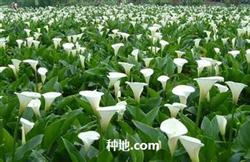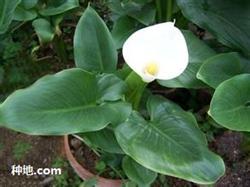Seeking: soilless cultivation technique of calla lotus

Seek: calla lotus soilless cultivation techniques, the more detailed the better calla lotus soilless cultivation can refer to the following: first, variety selection. The common horticultural varieties of calla lilies are white stalk, green stalk, red stalk and so on. White stalk species, small tubers, petiole base white-green, slow growth, white bracts, early flowering, more flowers, 1-2 cm diameter tubers can bloom. The green stalk seed tuber is thick, the petiole base is green, the growth momentum is prosperous, the plant is tall, the flower is yellow and white, the flower blooms late, and the tuber diameter must reach more than 5-6 cm before it can bloom. The growth potential of the red stalk species is medium, the petiole base is reddish, the flame bract is white, and the florescence is between the white stalk species and the green stalk species. In addition, there are some common horticultural species of the same genus as calla, such as honeysuckle calla lily, safflower calla lily, yellow calla lotus and so on. The main forms of soilless cultivation of calla lotus are pot culture and trough culture. Potted plants generally choose short and compact white stalk species, safflower calla lilies and honeysuckle calla lilies. For large plants, tall green stalk species or yellow calla lilies can be selected. The calla lily with the harvest bud as the cut flower is suitable for trough culture. Second, soilless cultivation system. The soilless cultivation system of calla is mainly composed of planting trough, drip irrigation system, nutrient pool, water pump and liquid supply timer. The planting trough can be built with bricks, with a width of 80 cm and a height of 20 cm. The length of the planting groove is determined by the actual length of the greenhouse, which generally requires no more than 30-40 cm. The trough is first covered with a layer of plastic film to isolate the soil, and then put in a substrate 15-18 cm thick. The substrates suitable for soilless culture of cut calla are rice husk ash and sawdust according to 3:1 volume ratio or perlite and sawdust mixed substrate according to 2:1 volume ratio. Drip irrigation system can use embedded drip irrigation belt, the distance of the outlet hole is 10 cm or 20 cm, and there are 2 planting grooves for each planting slot. The volume of nutrient pool is generally 1-2 cubic meters. The selection of water pump depends on the working pressure and quantity of drip irrigation belt. Generally, 3 greenhouses can use a submersible pump with a power of 450 watts to supply liquid. Third, planting. Soilless cultivation of calla lilies can be planted in late August. Select healthy and disease-free bulbs of the same size, and plant them in the planting trough according to the plant distance of 15 cm. The same size of the seed ball, the row spacing of 40 cm, the insertion depth of the seed ball is 3-4 cm. After planting, two drip irrigation belts were laid on the outside of the bulb to supply fluid. Fourth, nutrient solution management. The nutrient solution for soilless cultivation of calla lotus can be formulated as follows: 800 grams of calcium nitrate, 210 grams of potassium dihydrogen phosphate, 250 grams of magnesium sulfate, 500 grams of potassium nitrate, 30 grams of ammonium nitrate, 10 grams of ferric ethylenediamine tetraacetate, 2 grams of manganese sulfate, 1 gram of zinc sulfate, 1.3 grams of boric acid, 0.15 grams of copper sulfate and 0.1 grams of ammonium molybdate. In the early growth stage, the concentration of nutrient solution can be controlled at 1.2ms / cm, and it can be increased to 1.5ms/cm in the middle and later stage of growth, and the ph value of nutrient solution should be adjusted to 5.66.5 during the whole growth period. The supply of nutrient solution is mainly determined according to the weather conditions and plant size, generally 2-3 times a day to ensure that the cultivation substrate layer is moist, and there is a shallow water layer at the bottom of the trough. Fifth, plant management and pest control. The plant management of calla is relatively simple, mainly peeling off yellow leaves and some outer leaves. The purpose of stripping the outer leaves is to prevent leaf crowding from affecting daylighting and ventilation, and pedicels protruding. The main diseases and insect pests of calla lilies are bacterial soft rot, aphids, red spiders and so on. Bacterial soft rot can harm leaves, petioles and tubers, which is mainly transmitted by tubers. Bordeaux solution can be used to control the disease at the beginning of the disease. Click to get more calla lilies planting techniques click to get massive flowers and trees planting technology
- Prev

How to plant calla lilies?
How to plant calla lilies? What planting skills do you have? Calla lilies are also called water taros and mushroom flowers. Araceae, Calla. Its flower stem is elegant, the bud is as white as a horse's hoof, and the leaves are decorated with white spots, which can be described as unique flowers and leaves. For winter and spring important cut flowers, can be used for vase or made into bouquets, baskets, potted plants.
- Next

How to plant calla lilies with yellow flowers?
How to plant calla lilies with yellow flowers? What should pay attention to the yellow calla lily alias Amorphophallus, Araceae calla genus. First, an overview of the yellow calla lilies Ting Xiu elegant, golden buds, green leaves, decorated with white spots, can be described as two unique ornamental plants. At present, calla lilies are widely used in garden waterscape.
Related
- Fuxing push coffee new agricultural production and marketing class: lack of small-scale processing plants
- Jujube rice field leisure farm deep ploughing Yilan for five years to create a space for organic food and play
- Nongyu Farm-A trial of organic papaya for brave women with advanced technology
- Four points for attention in the prevention and control of diseases and insect pests of edible fungi
- How to add nutrient solution to Edible Fungi
- Is there any good way to control edible fungus mites?
- Open Inoculation Technology of Edible Fungi
- Is there any clever way to use fertilizer for edible fungus in winter?
- What agents are used to kill the pathogens of edible fungi in the mushroom shed?
- Rapid drying of Edible Fungi

